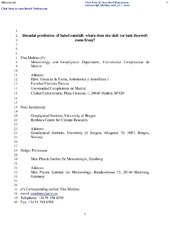Decadal prediction of Sahel rainfall: where does the skill (or lack thereof) come from?
Peer reviewed, Journal article
Accepted version

Åpne
Permanent lenke
https://hdl.handle.net/1956/15693Utgivelsesdato
2016-12Metadata
Vis full innførselSamlinger
- Geophysical Institute [1198]
Originalversjon
https://doi.org/10.1007/s00382-016-3416-9Sammendrag
Previous works suggest decadal predictions of Sahel rainfall could be skillful. However, the sources of such skill are still under debate. In addition, previous results are based on short validation periods (i.e. less than 50 years). In this work we propose a framework based on multi-linear regression analysis to study the potential sources of skill for predicting Sahel trends several years ahead. We apply it to an extended decadal hindcast performed with the MPI-ESM-LR model that span from 1901 to 2010 with 1 year sampling interval. Our results show that the skill mainly depends on how well we can predict the timing of the global warming (GW), the Atlantic multidecadal variability (AMV) and, to a lesser extent, the inter-decadal Pacific oscillation signals, and on how well the system simulates the associated SST and West African rainfall response patterns. In the case of the MPI-ESM-LR decadal extended hindcast, the observed timing is well reproduced only for the GW and AMV signals. However, only the West African rainfall response to the AMV is correctly reproduced. Thus, for most of the lead times the main source of skill in the decadal hindcast of West African rainfall is from the AMV. The GW signal degrades skill because the response of West African rainfall to GW is incorrectly captured. Our results also suggest that initialized decadal predictions of West African rainfall can be further improved by better simulating the response of global SST to GW and AMV. Furthermore, our approach may be applied to understand and attribute prediction skill for other variables and regions.